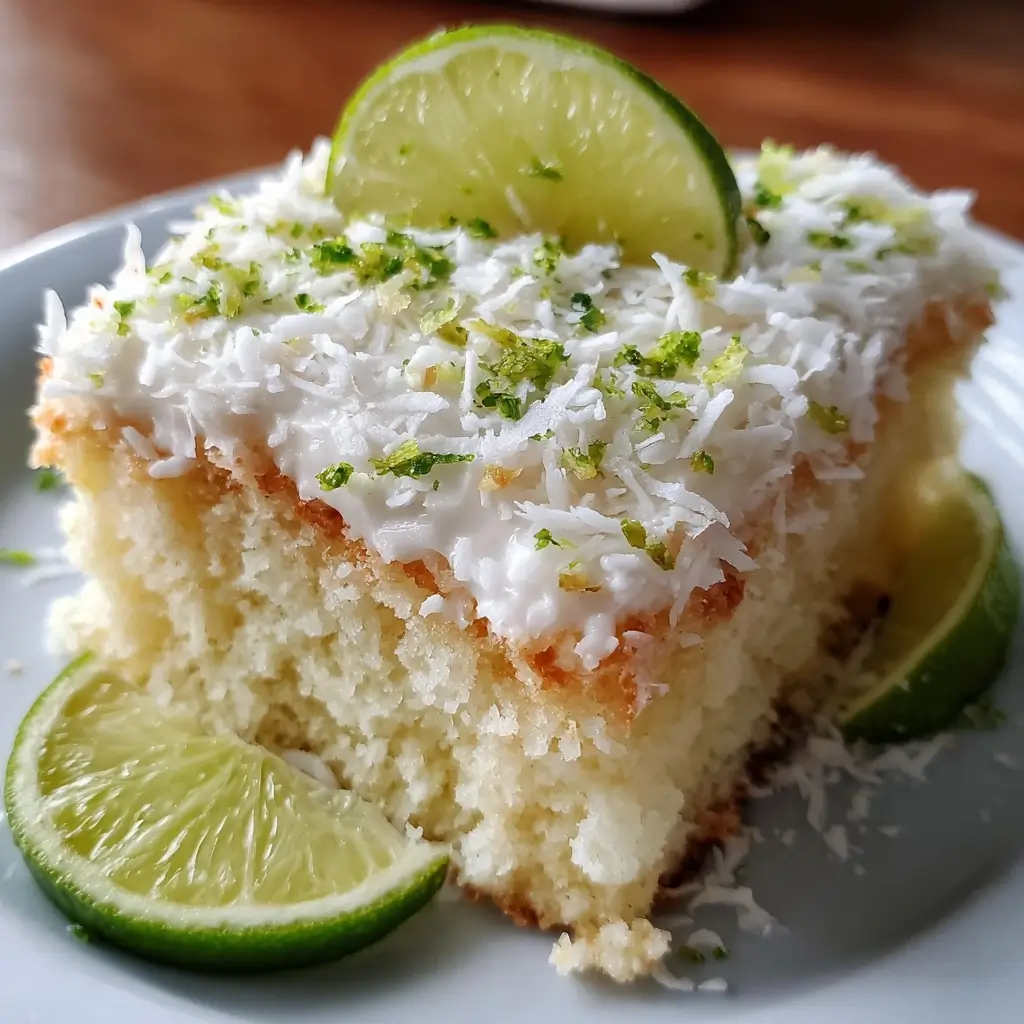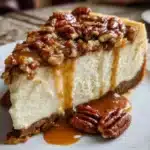Of all the desserts that have graced my kitchen, this Fluffy Coconut Lime Cake holds a truly special place. I first baked it on a whim for a family gathering, hoping to bring a little slice of tropical sunshine to an otherwise ordinary Sunday afternoon. The reaction was nothing short of extraordinary. My husband, who typically reserves his highest praise for chocolate desserts, declared it “the best cake he’s ever had.” The kids were mesmerized by the snowy-white frosting speckled with green lime zest, and their silence as they devoured their slices was the highest compliment a baker can receive. The magic of this cake lies in its perfect balance. It’s unbelievably moist and tender, with a delicate coconut crumb that melts in your mouth. Then, the bright, zesty punch of fresh lime cuts through the sweetness, creating a flavor profile that is both refreshing and deeply satisfying. It has since become our go-to celebration cake, requested for birthdays, holidays, and any occasion that calls for something truly memorable. It’s more than just a recipe; it’s a guaranteed showstopper that brings smiles and creates sweet memories.
Ingredients for the Ultimate Fluffy Coconut Lime Cake
To achieve the perfect balance of tropical coconut and zesty lime, using high-quality ingredients is key. Here is what you will need for both the cake and its signature frosting.
For the Coconut Lime Cake:
- 2 ½ cups (300g) all-purpose flour: Sifted to ensure a light and airy crumb. This is the structural foundation of our cake.
- 1 ½ cups (300g) granulated sugar: Provides the perfect amount of sweetness to balance the tart lime.
- 1 teaspoon baking powder: A leavening agent that helps the cake rise and become fluffy.
- ½ teaspoon baking soda: Works with the acidic ingredients to give the cake an extra lift.
- ½ teaspoon salt: Enhances all the other flavors in the cake.
- ½ cup (113g) unsalted butter: At room temperature, softened to cream perfectly with the sugar.
- 3 large eggs: At room temperature, to ensure they incorporate smoothly into the batter.
- 1 cup (240ml) full-fat canned coconut milk: Shaken well before measuring. This is the secret to a rich, moist, and flavorful coconut crumb. Do not use light coconut milk or coconut beverage from a carton.
- ½ cup (120ml) sour cream or full-fat Greek yogurt: At room temperature. This adds incredible moisture and a slight tang that complements the lime.
- 1 tablespoon fresh lime zest: From about 2-3 limes. This infuses the cake batter itself with a bright, citrusy aroma and flavor.
- 2 teaspoons vanilla extract: A classic flavor that rounds out the sweetness and complements the coconut.
- 1 cup (85g) sweetened shredded coconut: Gently folded into the batter for added texture and coconut flavor.
For the Zesty Lime Cream Cheese Frosting:
- 8 oz (226g) full-fat block cream cheese: Softened to room temperature for a lump-free, creamy frosting.
- ½ cup (113g) unsalted butter: Softened to room temperature.
- 4 cups (480g) powdered sugar: Sifted to remove any lumps and ensure a silky-smooth texture.
- ¼ cup (60ml) fresh lime juice: Provides the signature tangy flavor. Add more or less to taste.
- 1 tablespoon fresh lime zest: For that extra pop of lime flavor and visual appeal.
- 1 teaspoon vanilla extract: Balances the tanginess of the cream cheese and lime.
- Pinch of salt: Cuts the sweetness and makes the flavors pop.
- Toasted shredded coconut and extra lime zest: For garnish.
Step-by-Step Instructions to Bake a Perfect Cake
Follow these detailed instructions carefully to ensure your cake is a resounding success from the first mix to the final garnish.
Part 1: Making the Fluffy Coconut Lime Cake
- Preparation: Preheat your oven to 350°F (175°C). Grease and flour two 9-inch round cake pans. For extra insurance against sticking, trace the bottom of the pans onto parchment paper, cut out the circles, and place them in the bottom of the greased pans before flouring.
- Combine Dry Ingredients: In a large bowl, whisk together the sifted all-purpose flour, granulated sugar, baking powder, baking soda, and salt. Whisking thoroughly helps to evenly distribute the leavening agents, which is crucial for an even rise.
- Cream Butter and Sugar: In the bowl of a stand mixer fitted with the paddle attachment, or in a large bowl with a hand mixer, beat the softened unsalted butter on medium-high speed for about 2 minutes until it’s smooth and creamy. Add the granulated sugar and continue to beat for another 3-4 minutes until the mixture is light, pale, and fluffy. This process, called creaming, incorporates air into the batter, which is the first step to achieving a fluffy cake.
- Incorporate Eggs: Add the room temperature eggs one at a time, beating well after each addition and scraping down the sides of the bowl as needed. Wait until each egg is fully incorporated before adding the next. This prevents the batter from curdling. After the last egg is mixed in, beat in the vanilla extract and fresh lime zest.
- Mix Wet Ingredients: In a separate medium bowl, whisk together the full-fat coconut milk and the sour cream (or Greek yogurt) until smooth.
- Alternate Wet and Dry: With the mixer on low speed, add the dry ingredients to the butter mixture in three additions, alternating with the coconut milk mixture in two additions. Begin and end with the dry ingredients (Dry, Wet, Dry, Wet, Dry). Mix until just combined after each addition. It is crucial not to overmix the batter at this stage, as it can develop the gluten in the flour and result in a tough, dense cake.
- Fold in Coconut: Remove the bowl from the mixer. Using a rubber spatula, gently fold in the sweetened shredded coconut. Give the batter a final few folds from the bottom up to ensure everything is well combined without deflating the air you incorporated.
- Bake the Cakes: Divide the batter evenly between the two prepared cake pans and smooth the tops with your spatula. Bake for 30-35 minutes, or until a wooden skewer or toothpick inserted into the center of the cakes comes out clean or with a few moist crumbs attached. The cake should be golden brown and spring back when lightly touched.
- Cool Completely: Let the cakes cool in their pans on a wire rack for 15-20 minutes. Then, carefully run a thin knife around the edges of the pans and invert the cakes onto the wire rack. Peel off the parchment paper and let them cool completely to room temperature before frosting. This is a critical step; frosting a warm cake will result in a melted, soupy mess.
Part 2: Whipping Up the Frosting & Assembling
- Beat Cream Cheese and Butter: In the clean bowl of your stand mixer with the paddle attachment (or a large bowl with a hand mixer), beat the softened cream cheese and softened butter together on medium-high speed until the mixture is completely smooth, creamy, and free of lumps, about 3-4 minutes.
- Add Sugar and Liquids: Reduce the mixer speed to low and gradually add the sifted powdered sugar, about one cup at a time. Once all the sugar is incorporated, add the fresh lime juice, lime zest, vanilla extract, and a pinch of salt.
- Whip to Perfection: Increase the mixer speed to medium-high and whip the frosting for 2-3 minutes until it is light, airy, and spreadable. If the frosting is too thin, add a bit more powdered sugar. If it’s too thick, add a teaspoon of lime juice or milk at a time until you reach the desired consistency.
- Assemble the Cake: Place one of the completely cooled cake layers on your serving plate or cake stand. Spread a generous layer of frosting over the top, about 1 to 1 ½ cups. Carefully place the second cake layer on top.
- Crumb Coat (Optional but Recommended): Apply a thin layer of frosting over the top and sides of the entire cake. This is called a “crumb coat” and it traps any loose crumbs. Place the cake in the refrigerator for 20-30 minutes to set this layer. This step ensures your final coat of frosting will be clean and crumb-free.
- Final Frosting: After the crumb coat is set, apply the remaining frosting generously over the top and sides of the cake, using an offset spatula to create smooth sides or decorative swirls.
- Garnish and Chill: Decorate the top of the cake with toasted shredded coconut and some extra lime zest. For an elegant touch, add a few thin slices of fresh lime. Refrigerate the cake for at least 30-60 minutes before slicing. This helps the frosting set and makes for cleaner slices.
Nutrition Facts at a Glance
The nutritional information is an estimate and can vary based on the specific ingredients used.
- Servings: 12-16 slices
- Calories per Serving: Approximately 480-550 kcal
- Fat: This cake contains a significant amount of fat from the butter, cream cheese, and full-fat coconut milk, which contributes to its rich flavor and moist texture.
- Carbohydrates: The primary source of energy, coming mainly from the flour and sugars in the cake and frosting.
- Sugars: A dessert for special occasions, this cake is high in sugar, providing its signature sweetness.
- Protein: A moderate amount of protein is present from the eggs, flour, and dairy components.
- Sodium: The small amount of salt used enhances the overall flavor profile by balancing the sweetness.
Preparation and Cooking Time
This showstopper cake requires some time and love, but the results are well worth the effort.
- Preparation Time: 30 minutes (mixing batter and frosting)
- Cooking Time: 30-35 minutes
- Cooling & Assembly Time: Approximately 2 hours (includes cooling cakes, chilling, and frosting)
- Total Time: Approximately 3 hours
How to Serve Your Coconut Lime Masterpiece
Presentation can elevate your beautiful cake into a truly stunning centerpiece. Here are some ideas for serving:
- Garnish Generously: Don’t skimp on the final touches!
- Toasted Coconut: Spread shredded coconut on a baking sheet and toast at 350°F (175°C) for 5-7 minutes, watching carefully until golden brown. The nutty, toasted flavor is a fantastic contrast to the fresh cake.
- Fresh Lime Zest: A final sprinkle of bright green zest over the white frosting is visually striking and adds a burst of fresh aroma.
- Lime Twists or Slices: Thinly sliced limes or elegant lime twists placed in the center or around the edge of the cake look professional and hint at the flavor inside.
- Serve at the Right Temperature: For the best flavor and texture, remove the cake from the refrigerator about 20-30 minutes before serving. This allows the butter in the cake and frosting to soften slightly, making it more tender and flavorful.
- Perfect Pairings:
- Beverages: This cake pairs wonderfully with a hot cup of black coffee, a simple green tea, or an herbal tea like chamomile or mint. For an evening treat, a light, crisp white wine like a Sauvignon Blanc or a tropical-themed cocktail would be an excellent match.
- Accompaniments: While a standalone star, a small scoop of vanilla bean ice cream or a dollop of unsweetened whipped cream can add another layer of creamy indulgence.
Additional Tips for a Flawless Cake
- Room Temperature is Non-Negotiable: This is the most important rule in baking this cake. Room temperature butter, eggs, sour cream, and cream cheese emulsify and combine much more smoothly. This creates a uniform batter, trapping air effectively, which leads to a fluffier, more tender cake with a finer crumb. Cold ingredients can cause the batter to curdle and result in a dense, heavy cake.
- The Perils of Overmixing: Once you start adding the dry ingredients to the wet, mix only until they are just combined. Overmixing develops the gluten in the flour, which is great for chewy bread but disastrous for a cake. It will make your final product tough and dense instead of light and fluffy.
- Measure Flour Correctly: How you measure your flour can dramatically impact your cake’s texture. Instead of scooping the flour directly out of the bag with your measuring cup (which compacts it), use a spoon to fluff up the flour in its container. Then, spoon the flour into your measuring cup until it’s overflowing, and use the back of a knife to level it off. This “spoon and level” method prevents you from using too much flour, which can lead to a dry cake.
- Don’t Rely Solely on a Timer: Ovens can vary, so always test your cake for doneness. The toothpick test is reliable—it should come out clean or with a few moist crumbs. You can also gently press the top of the cake; if it springs back, it’s ready. If your finger leaves an indent, it needs more time.
- Toast Your Coconut for Deeper Flavor: While you can use untoasted coconut, toasting it brings out a nutty, complex flavor that elevates the entire cake. It also provides a lovely crunchy texture contrast to the soft crumb and creamy frosting. Just watch it carefully, as it can go from golden to burnt very quickly.
- Fresh is Best for Lime: Always use freshly squeezed lime juice and freshly grated zest. The flavor from bottled lime juice is often muted and can have a slightly artificial taste. The natural oils in fresh zest provide an irreplaceable aromatic punch that infuses the entire cake and frosting with authentic, vibrant citrus flavor.
- Make-Ahead Strategy: You can bake the cake layers a day in advance. Once they are completely cool, wrap them tightly in plastic wrap and store them at room temperature. The frosting can also be made a day or two ahead and stored in an airtight container in the refrigerator. Just let it sit at room temperature for about 30 minutes and give it a quick whip with your mixer to restore its fluffy texture before frosting the cake.
- Embrace the Crumb Coat: It might seem like an extra, fussy step, but a crumb coat is a professional baker’s secret to a beautifully finished cake. This thin initial layer of frosting traps all the loose crumbs, preventing them from mixing into your final, pristine layer of frosting. It’s a small investment of time for a much more polished result.
Frequently Asked Questions (FAQ)
Q1: Can I make this recipe into cupcakes?
A1: Absolutely! This recipe works beautifully for cupcakes. Simply line a muffin tin with paper liners and fill each one about two-thirds full with batter. Bake at 350°F (175°C) for about 18-22 minutes, or until a toothpick inserted into the center comes out clean. This recipe should yield approximately 24 cupcakes. Allow them to cool completely before frosting.
Q2: How do I store leftover Fluffy Coconut Lime Cake?
A2: Because of the cream cheese frosting, the cake must be stored in the refrigerator. Place it in an airtight cake carrier or cover it loosely with plastic wrap (you can insert toothpicks around the edge to prevent the wrap from sticking to the frosting). It will stay fresh and delicious for up to 4-5 days. Remember to let it sit at room temperature for 20-30 minutes before serving for the best texture.
Q3: Can I freeze this cake?
A3: Yes, this cake freezes very well. You can freeze the unfrosted cake layers by wrapping them tightly in two layers of plastic wrap and then a layer of aluminum foil. They can be frozen for up to 2 months. To freeze the frosted cake, place the entire cake in the freezer uncovered for about an hour until the frosting is firm. Then, wrap it tightly in plastic wrap and foil. To thaw, unwrap the cake while still frozen (to prevent condensation from making the frosting sticky) and let it thaw in the refrigerator overnight.
Q4: My cake turned out dense and not fluffy. What did I do wrong?
A4: A dense cake is usually caused by a few common issues. The most likely culprit is overmixing the batter after adding the flour, which develops gluten. Another possibility is that your ingredients, particularly the butter and eggs, were too cold. Finally, ensure your baking powder and baking soda are fresh; expired leavening agents won’t give the cake the lift it needs.
Q5: Can I use coconut oil instead of butter in the cake?
A5: You can substitute melted and cooled coconut oil for the butter in a 1:1 ratio. This will intensify the coconut flavor. However, you won’t be able to “cream” it with the sugar in the same way. Instead, you would whisk the melted coconut oil with the sugar. The final texture may be slightly different—less “fluffy” and more “tender and moist”—but it will still be incredibly delicious.
Q6: What is the best kind of coconut milk to use?
A6: For the best results, you must use full-fat, unsweetened coconut milk from a can. Do not use the coconut milk beverage that comes in a carton, as it is much thinner and will not provide the same richness, fat content, or moisture. Be sure to shake the can well before opening, as the cream and water can separate.
Q7: Can I make this recipe gluten-free?
A7: Yes, you can adapt this recipe to be gluten-free. Use a high-quality, 1-to-1 gluten-free all-purpose flour blend that contains xanthan gum. Measure the flour by weight if possible for the most accurate results. The texture might be slightly more delicate, but the flavor will be just as wonderful.
Q8: My frosting is too runny. How can I fix it?
A8: If your frosting is runny, it’s usually because your cream cheese or butter was too soft (almost melted) or you added too much liquid. The easiest fix is to add more sifted powdered sugar, about a quarter cup at a time, until it reaches the desired thickness. You can also try chilling the frosting in the refrigerator for 20-30 minutes; as the butter and cream cheese firm up, the frosting will thicken.






